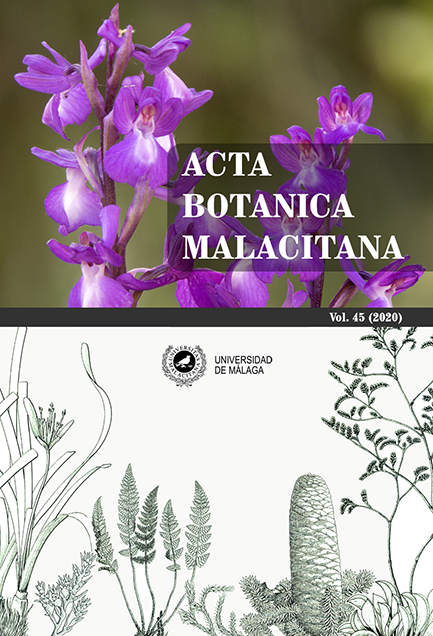A naturalized population of Broussonetia papyrifera (L.) Vent. in the interior of the Iberian Peninsula
DOI:
https://doi.org/10.24310/abm.v45i.6389Keywords:
Castilla-La Mancha, Tagus River, Toledo, alien plamts, riparian vegetationAbstract
In the present work, a naturalized population of Broussonetia papyrifera (L.) Vent located, for the first time, in the banks of the Tajo river (Toledo) is mentioned. Given the invasive potential of this species, the need for its control and monitoring is proposed.
Downloads
Metrics
References
Bayón, Á., & Vilà, M. (2019). Horizon scanning to identify invasion risk of ornamental plants markete in Spain. NeoBiota, 52, 47-86 doi: https://doi.org//10.3897/neobiota.52.38113
Bolòs, O. de & Vigo, J. (1990). Flora dels Països Catalans. vol. 2: (Crucíferes-Amarantàcies). Barcelona
Bosu, P., Apetorgbor, M. M., E. Nkrumah, Elvis & P. Bandoh, Kwabena. (2013). The impact of Broussonetia papyrifera (L.) Vent. on community characteristics in the forest and forest-savannah transition ecosystems of Ghana. African Journal of Ecology. 51(4), 528-535 https://doi. org/10.1111/aje. 12063
CABI 2020. Broussonetia papyrifera In Invasive Species Compendium. Wallingford, UK: CAB International. https://www.cabi.org/isc/datasheet/10017 [consultado 17 Junio 2020]
Castroviejo, S. (1993). Moraceae In Castroviejo, S., Aedo, C., Laínz, M., Muñoz Garmendia, F., Nieto Feliner, G., Paiva, J. & Benedí, C. (Eds.), Flora iberica 3, 251-256. Real Jardín Botánico, CSIC, Madrid.
Costa, M., Peris, J. B., & Stu?bing, G. (1986). Notas corológicas levantinas VI. Studia Botanica, 5, 123-125.
De Almeida & Freitas. (2006). Exotic flora of Continental Portugal-A reassessment. Botanica complutensis, 30, 117-130.
EPPO (2020). European and Mediterranean Plant Protection Organization Global Database. https://gd.eppo.int/taxon/BRNPA/categorization [consultado 17 Junio 2020]
GBIF (2020). Broussonetia papyrifera in Occurrence dataset https://www.gbif. org/species/5361944 accessed via GBIF. org on 2020-06-17
Ghersa, C. M., de La Fuente, E., Suarez, S., & Leon, R. J. C. (2002). Woody species in the Rolling Pampa grasslands, Argentina. Agriculture, Ecosystems and Environment, 88, 271-278.
GRIIS (2020). Global Register of Introduced and Invasive Species. Accessed via http://www. griis. org/ on 2020-06-17
Guillot Ortiz, D. (2009). Flora ornamental española: aspectos históricos y principales especies. Monografías de la Revista Bouteloua, 8, 1-273.
Kornás, J. (1990). Plant invasions in Central Europe: Historical and ecological aspects. In Di Castri, F., Hansen, A. J. & Debussche, M. (Eds.), Biological Invasions in Europe and the Mediterranean Basin, (pp. 19-36). Kluwer Acad. Publ. Dordrecht. The Netherlands.
Laguna, M. (1870). Resumen de los trabajos verificados por la Comisión de la Flora Forestal Española durante los años de 1867 y 1868. Madrid Impr. del Colegio Nacional de Sordo-mudos y de Ciegos.
Malik, R. & Husain, S. Z. (2007). Broussonetia payprifera: an environmental constraint on the Himalayan foothills vegetation. Pakistan Journal of Botany, 39, 1045-1053.
Salvat, A & Ernériz J (2017). Parc Natural del Montseny: Plantes exòtiques invasores: Guia d'identificació i substitució en jardineria. Diputación de Barcelona.
Sanz-Elorza, M., Dana, E. D. & Sobrino, E. (2004, eds.). Atlas de las Plantas Alóctonas Invasoras en España. Dirección General para la Biodiversidad. Madrid.
Sobrino, E., Sanz-Elorza, M., Dana, E. D. & González-Moreno, A. (2002). Invasibility of a coastal strip in NE Spain by alien plants. Journal of Vegetation Science, 13(4), 585-594.
Downloads
Published
How to Cite
Issue
Section
License
All information related to the licensing of published works in Acta Botanica Malacitana and copyright can be found in our Editorial Policy.







1.png)
